Marujo do Rosario
-
Ships in 1 to 2 weeks
Details
Description
SKU: CF.CM9602
Composed by Brazilian Folk Song. Arranged by Eduardo Lakschevitz Elisa Dekaney. Fold. Performance Score. 12 pages. Duration 2 minutes, 28 seconds. Carl Fischer Music #CM9602. Published by Carl Fischer Music (CF.CM9602).ISBN 9781491154243. UPC: 680160912742. 6.875 x 10.5 inches. Key: Gb major. Portuguese. Brazilian Folk Song.
According to Ermelinda Paz , Marujo do Rosario (literally translated from the Portuguese as Sailor of the Rosary) comes from the hydrographic region of the Sao Francisco River, a basin that includes the states of Minas Gerais, Bahia, Pernambuco, Sergipe, and Alagoas. This song most likely belongs to a style of dramatic dance called cheganca-de-marujo (arrival of sailor). In this tragicomic street drama, the community of actors enact a story in which they demonstrate their experiences as if they were in a vessel lost at sea. In this dance, several characters dressed as sailors and carrying small sail boats on their shoulders, parade through the streets singing and dancing to a march. When they arrive at a determined house, they place their little sail boats on the floor and start the dramatic play. This song seems to be performed when the sailors arrive at the chosen location. The Portuguese lyrics E com licenca e, olele, e com licenca do dono da casa, o e com licenca e means please excuse me, I have permission from the houses owner to come in. This arrangement is scored for three-part mixed with optional baritone, piano, and pandeiro. The pandeiro is a Brazilian frame drum with jingles played with the hands, similar to the orchestral tambourine. It is used in various music styles but particularly in samba and bossa nova. In fact, feel free to substitute the pandeiro with the orchestral tambourine. The text is very short and simple. To make your singers Portuguese pronunciation more accurate, do not close final m or n. Just nasalize them. IPA Transcription E com licenca olele e [? k? li'sensa olele e] E com licenca do dono da casa [? k? li'sensa du d?nu da kaza].
According to Ermelinda Paz , Marujo do RosA!rio (literally translated from the Portuguese as aSailor of the Rosarya) comes from the hydrographic region of the SAPSo Francisco River, a basin that includes the states of Minas Gerais, Bahia, Pernambuco, Sergipe, and Alagoas. This song most likely belongs to a style of dramatic dance called acheganASSa-de-marujoa (arrival of sailor). In this tragicomic street drama, the community of actors enact a story in which they demonstrate their experiences as if they were in a vessel lost at sea. In this dance, several characters dressed as sailors and carrying small sail boats on their shoulders, parade through the streets singing and dancing to a march. When they arrive at a determined house, they place their little sail boats on the floor and start the dramatic play. This song seems to be performed when the sailors arrive at the chosen location. The Portuguese lyrics aA com licenASSa Aa, A'lelAa, A(c) com licenASSa do dono da casa, A' Aa com licenASSa Aaa means aplease excuse me, I have permission from the houseas owner to come in.a This arrangement is scored for three-part mixed with optional baritone, piano, and pandeiro. The pandeiro is a Brazilian frame drum with jingles played with the hands, similar to the orchestral tambourine. It is used in various music styles but particularly in samba and bossa nova. In fact, feel free to substitute the pandeiro with the orchestral tambourine. The text is very short and simple. To make your singers Portuguese pronunciation more accurate, do not close final ama or an.a Just nasalize them. IPA Transcription A com licenASSa olelAa Aa [E kE li'sensa oleale e] A com licenASSa do dono da casa [E kE li'sensa du adEnu da akaza].
According to Ermelinda Paz , Marujo do Rosario (literally translated from the Portuguese as "Sailor of the Rosary") comes from the hydrographic region of the Sao Francisco River, a basin that includes the states of Minas Gerais, Bahia, Pernambuco, Sergipe, and Alagoas. This song most likely belongs to a style of dramatic dance called "cheganca-de-marujo" (arrival of sailor). In this tragicomic street drama, the community of actors enact a story in which they demonstrate their experiences as if they were in a vessel lost at sea. In this dance, several characters dressed as sailors and carrying small sail boats on their shoulders, parade through the streets singing and dancing to a march. When they arrive at a determined house, they place their little sail boats on the floor and start the dramatic play. This song seems to be performed when the sailors arrive at the chosen location. The Portuguese lyrics "E com licenca e, olele, e com licenca do dono da casa, o e com licenca e" means "please excuse me, I have permission from the house's owner to come in." This arrangement is scored for three-part mixed with optional baritone, piano, and pandeiro. The pandeiro is a Brazilian frame drum with jingles played with the hands, similar to the orchestral tambourine. It is used in various music styles but particularly in samba and bossa nova. In fact, feel free to substitute the pandeiro with the orchestral tambourine. The text is very short and simple. To make your singers Portuguese pronunciation more accurate, do not close final "m" or "n." Just nasalize them. IPA Transcription E com licenca olele e [e k^ li'sensa ole'le e] E com licenca do dono da casa [e k^ li'sensa du 'd^nu da 'kaza].
According to Ermelinda Paz, Marujo do Rosario (literally translated from the Portuguese as "Sailor of the Rosary") comes from the hydrographic region of the Sao Francisco River, a basin that includes the states of Minas Gerais, Bahia, Pernambuco, Sergipe, and Alagoas. This song most likely belongs to a style of dramatic dance called "cheganca-de-marujo" (arrival of sailor). In this tragicomic street drama, the community of actors enact a story in which they demonstrate their experiences as if they were in a vessel lost at sea. In this dance, several characters dressed as sailors and carrying small sail boats on their shoulders, parade through the streets singing and dancing to a march. When they arrive at a determined house, they place their little sail boats on the floor and start the dramatic play. This song seems to be performed when the sailors arrive at the chosen location. The Portuguese lyrics "E com licenca e, olele, e com licenca do dono da casa, o e com licenca e" means "please excuse me, I have permission from the house's owner to come in." This arrangement is scored for three-part mixed with optional baritone, piano, and pandeiro. The pandeiro is a Brazilian frame drum with jingles played with the hands, similar to the orchestral tambourine. It is used in various music styles but particularly in samba and bossa nova. In fact, feel free to substitute the pandeiro with the orchestral tambourine. The text is very short and simple. To make your singers Portuguese pronunciation more accurate, do not close final "m" or "n." Just nasalize them. IPA Transcription E com licenca olele e [e k^ li'sensa ole'le e] E com licenca do dono da casa [e k^ li'sensa du 'd^nu da 'kaza].
According to Ermelinda Paz, Marujo do Rosário (literally translated from the Portuguese as “Sailor of the Rosary”) comes from the hydrographic region of the São Francisco River, a basin that includes the states of Minas Gerais, Bahia, Pernambuco, Sergipe, and Alagoas. This song most likely belongs to a style of dramatic dance called “chegança-de-marujo” (arrival of sailor). In this tragicomic street drama, the community of actors enact a story in which they demonstrate their experiences as if they were in a vessel lost at sea. In this dance, several characters dressed as sailors and carrying small sail boats on their shoulders, parade through the streets singing and dancing to a march. When they arrive at a determined house, they place their little sail boats on the floor and start the dramatic play. This song seems to be performed when the sailors arrive at the chosen location. The Portuguese lyrics “É com licença ê, ôlelê, é com licença do dono da casa, ô ê com licença ê” means “please excuse me, I have permission from the house’s owner to come in.”This arrangement is scored for three-part mixed with optional baritone, piano, and pandeiro. The pandeiro is a Brazilian frame drum with jingles played with the hands, similar to the orchestral tambourine. It is used in various music styles but particularly in samba and bossa nova. In fact, feel free to substitute the pandeiro with the orchestral tambourine. The text is very short and simple. To make your singers Portuguese pronunciation more accurate, do not close final “m” or “n.” Just nasalize them.IPA TranscriptionÉ com licença olelê ê[ɛ kʌ li'sensa ole‘le e]É com licença do dono da casa[ɛ kʌ li'sensa du ‘dʌnu da ‘kaza].
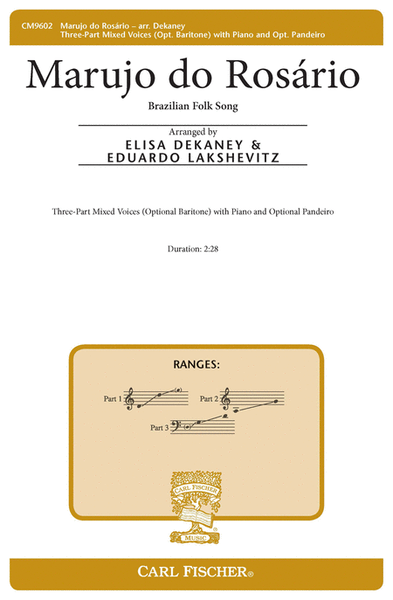
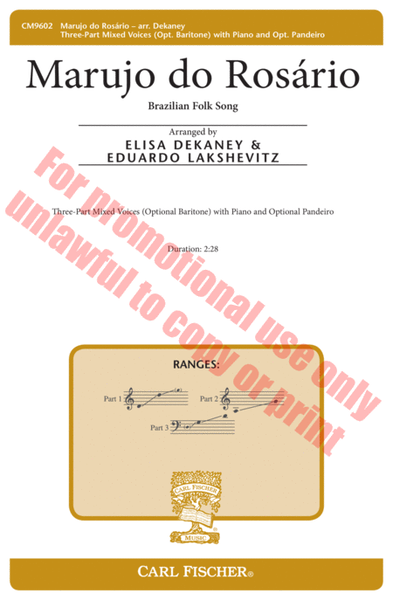
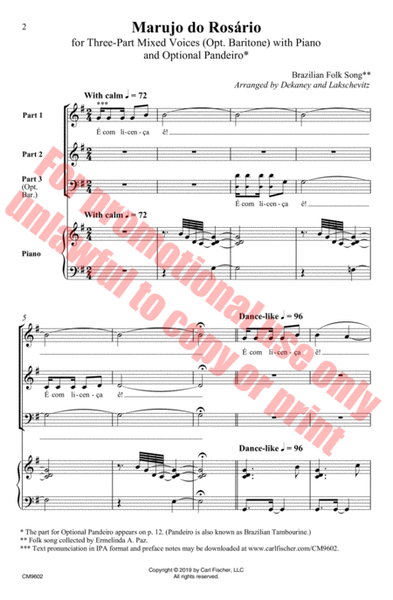
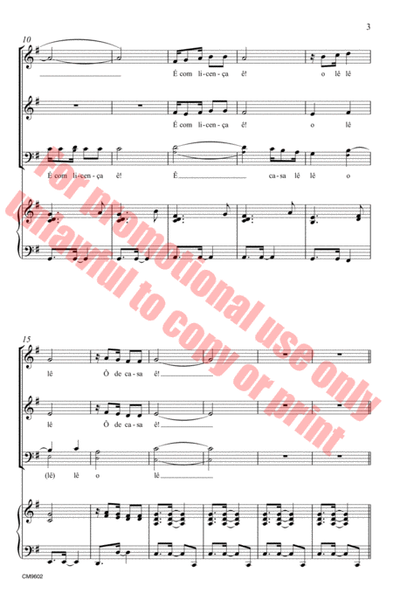
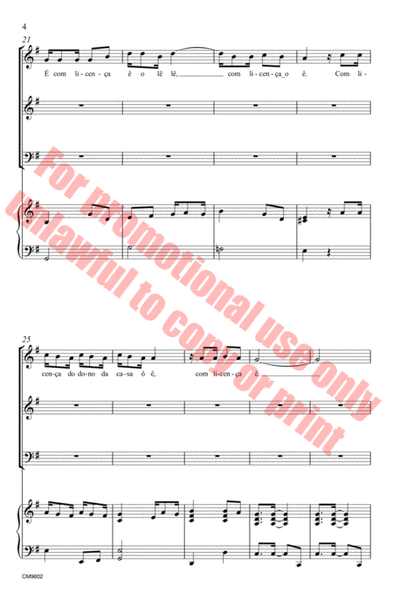
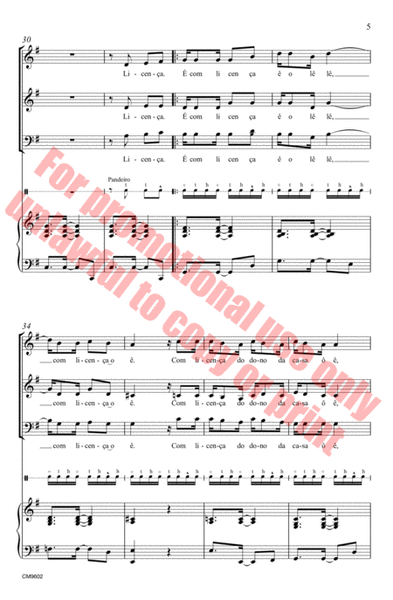
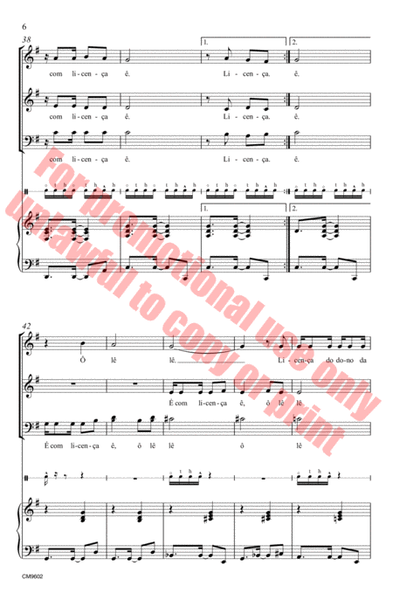

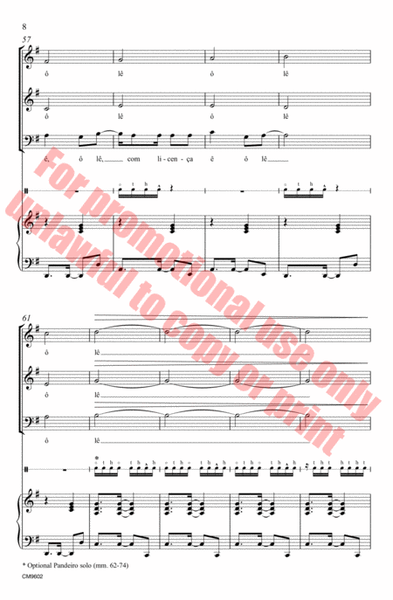
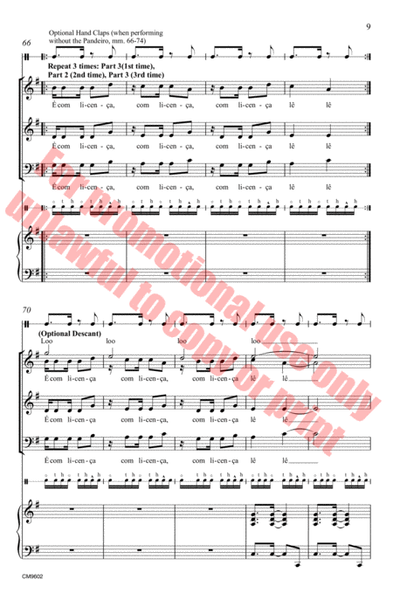
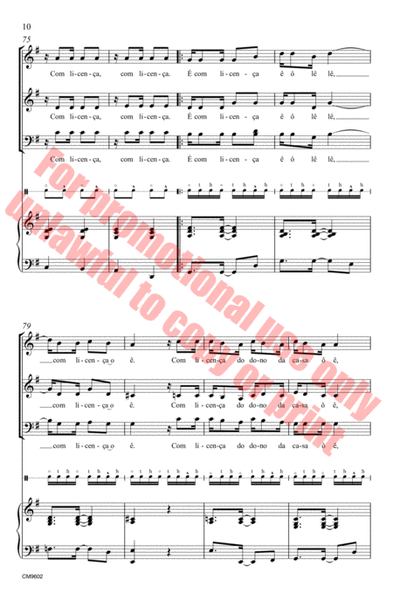
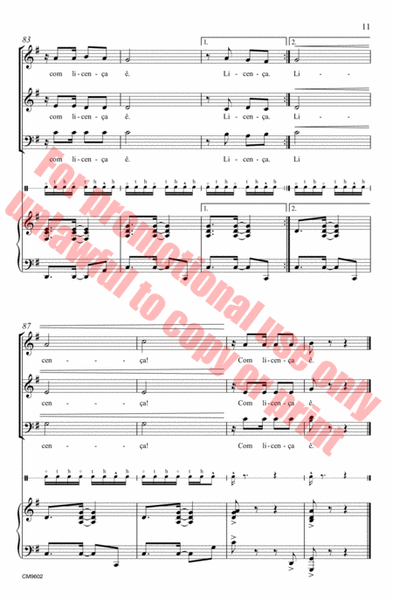
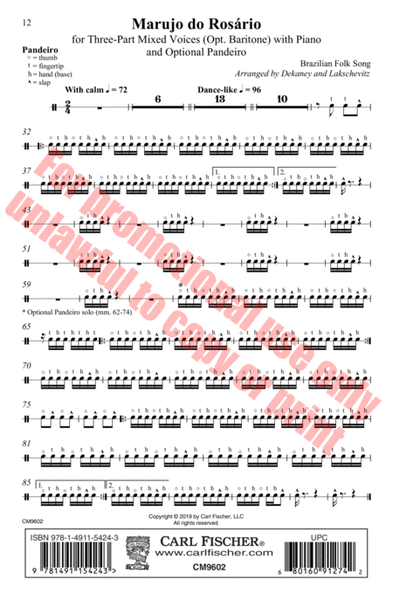
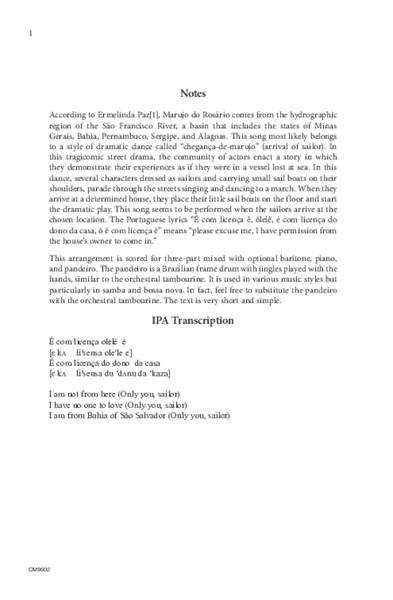
 Share
Share